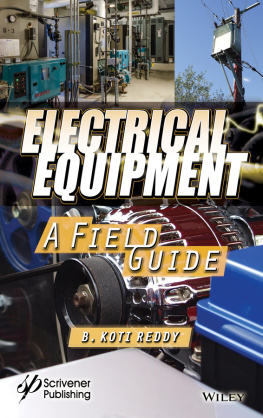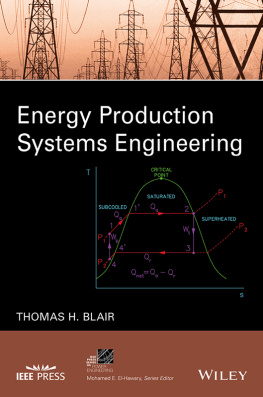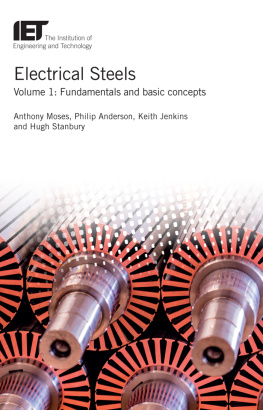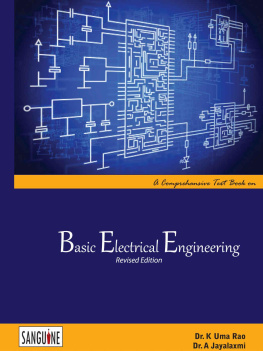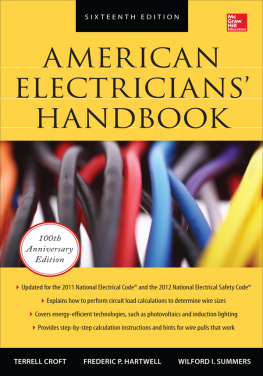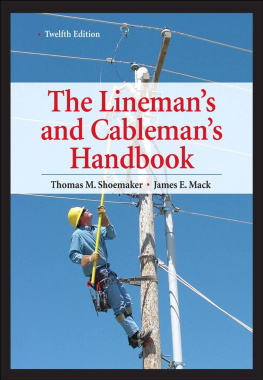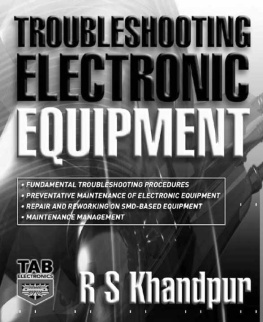
Scrivener Publishing
100 Cummings Center, Suite 541J
Beverly, MA 01915-6106
Publishers at Scrivener
Martin Scrivener ()
Phillip Carmical ()
Electrical Equipment
A Field Guide
B. Koti Reddy

This edition first published 2021 by John Wiley & Sons, Inc., 111 River Street, Hoboken, NJ 07030, USA and Scrivener Publishing LLC, 100 Cummings Center, Suite 541J, Beverly, MA 01915, USA
2021 Scrivener Publishing LLC
For more information about Scrivener publications please visit www.scrivenerpublishing.com.
All rights reserved. No part of this publication may be reproduced, stored in a retrieval system, or transmitted, in any form or by any means, electronic, mechanical, photocopying, recording, or otherwise, except as permitted by law. Advice on how to obtain permission to reuse material from this title is available at http://www.wiley.com/go/permissions.
Wiley Global Headquarters
111 River Street, Hoboken, NJ 07030, USA
For details of our global editorial offices, customer services, and more information about Wiley products visit us at www.wiley.com.
Limit of Liability/Disclaimer of Warranty
While the publisher and authors have used their best efforts in preparing this work, they make no representations or warranties with respect to the accuracy or completeness of the contents of this work and specifically disclaim all warranties, including without limitation any implied warranties of merchantability or fitness for a particular purpose. No warranty may be created or extended by sales representatives, written sales materials, or promotional statements for this work. The fact that an organization, website, or product is referred to in this work as a citation and/or potential source of further information does not mean that the publisher and authors endorse the information or services the organization, website, or product may provide or recommendations it may make. This work is sold with the understanding that the publisher is not engaged in rendering professional services. The advice and strategies contained herein may not be suitable for your situation. You should consult with a specialist where appropriate. Neither the publisher nor authors shall be liable for any loss of profit or any other commercial damages, including but not limited to special, incidental, consequential, or other damages. Further, readers should be aware that websites listed in this work may have changed or disappeared between when this work was written and when it is read.
Library of Congress Cataloging-in-Publication Data
ISBN 9781119768944
Cover image: Pixabay.com and Wikimedia Commons
Cover design by Russell Richardson
Set in size of 11pt and Minion Pro by Manila Typesetting Company, Makati, Philippines
Printed in the USA
10 9 8 7 6 5 4 3 2 1
Foreword
At the outset, I wish to congratulate Mr. B. Koti Reddy, the author of the Electrical Equipment: A Field Guide, for writing this high utility book, bringing out many practical aspects of all major equipments we find in power generation and distribution systems. He has put forth in this book all the practical experience he has acquired in the decades of his service at a government of India organization.
The first four chapters of the book deal with the major constituents of a power supply system, generators, transformers and induction motors. These chapters supplement the fundamental theoretical aspects, like development of equivalent circuits, phasor diagrams, etc., of these equipments that are normally dealt with in regular textbooks of our undergraduate programs, with the vital aspects of international standards, testing and maintenance procedures and condition monitoring of these equipments and systems.
In , the salient protective system components which are employed in power systems are dealt with, including circuit breakers, relay systems, current transformers, and potential transformers. Also covered are the philosophy of protection, schemes, operation and their coordination, three-phase winding connections, etc., including their testing and maintenance procedures.
deals with the cables and overhead lines, which are part and parcel of any industrial electricity supply system. Due emphasis has been placed on the selection, testing, fault location and type identification procedures.
Nowadays, a lot of importance is being given to generating power from renewable energy sources to counter the challenges of global warming and climate change. In this context, the installation of solar photovoltaic power generation systems has assumed great importance. Also, because most of the renewable energy sources fluctuate and vary according to the time of day and the season, it has become essential to develop, design and install energy storage systems like the battery energy storage systems to reliably operate the integrated systems.
deal with all the aspects of photovoltaic systems and battery energy storage systems, respectively.
For installing any new industrial or plant electrical system, the design is first carried out in computer simulations using the software tools like ETAP, PSCAD or MATLAB simulink and only then is the hardware design is done.
deals with how these software tools are effectively used in the design of the system.
For implementing energy conservation schemes, efficient systems with LED lighting of residential, commercial and industrial complexes have become essential and this is the subject matter of .
Finally, the safety aspects of all electrical installations in the residential, commercial, industrial and distribution utility substations are of paramount importance and these are dealt with in .
In conclusion, I wish to state that there are very few books available addressing all these practical aspects of electrical system design, installation, testing, maintenance and operation of modern electrical power systems. As a professor who has taught in various educational institutes like IITs and state university colleges, I feel a great need exists for introducing a core course like this at the final year undergraduate level for all electrical power engineering programs. This will facilitate the graduating students becoming readily employable in the field. This can also be a very suitable course for outgoing polytechnic students.
Dr. R. Balasubramanian
NTPC Chair Professor (Rtd.)
Indian Institute of Technology, Delhi
Preface
In the past, too much emphasis has been given to basic theory and analytical problems, both in academic texts and handbooks of electrical engineering. Even the in-depth study of these books cannot bridge the gap between the academic curriculum and the work at the application field. Hence there is a need for a suitable guide to work with various electrical appliances at field that will be useful for electrical engineering graduates.
The author has been practicing electrical power systems for almost three decades, from selection of electrical equipment, to their operation and maintenance through their commissioning and testing with the advancement of technology and percolation of power electronics, digital controllers, computers and information technology. The face of electrical engineering is changing day by day, which necessitates regular updating, retrofits and up gradations by field practitioners. This requires thorough understanding of field equipment or appliances which thus enables the engineer to understand it practically from the operation and maintenance point of view. This is possible once the field engineer understands any equipment thoroughly by reading the technical specifications from the rating plate. This field book guides practitioners to deal with the above concept and the equipment to be dealt with, which are chosen according to present industry requirements.
Next page
